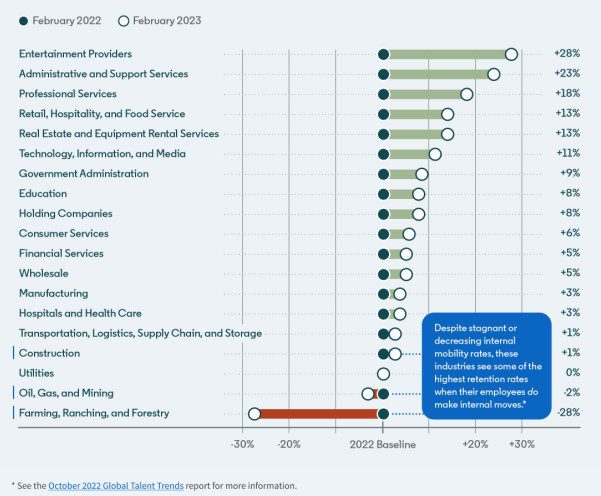Internal mobility drives down attrition
Says LinkedIn’s latest report.
Why You Should Care
Hiring is slowing down.
Therefore, employers need to focus on retaining their top talent - and the key is internal mobility.
Check out LinkedIn's insights on how to do this well.
Ongoing economic uncertainty is causing hiring to continue to slow down across the world, according to recent data from LinkedIn.
Therefore, “one of the key challenges facing businesses in the year ahead will be how to attract, retain and motivate talent”, shared Becky Schnauffer, head of global clients at LinkedIn Talent Solutions.
The good news is that as employers lean into retention, they are specifically focusing on internal mobility. Companies whose employees learn on the job have 7% higher retention rates, according to LinkedIn’s report.
The data also shows that internal mobility has been trending up between February 2022 and February 2023 in 16 of 19 industries measured by LinkedIn.
And, in fact, two of the three sectors where internal mobility is on the decline – oil, gas and mining and farming – saw super high retention rates when people were moving jobs in the business.

Credit: LinkedIn, Global Talent Trends Report, May 2023.
In this context, employers, and particularly HR teams, need to lean into skills.
Schnauffer added: “Our research shows that employees are increasingly looking to work for companies that provide them with opportunities to grow and advance in their careers, and those that learn new skills on the job are more likely to stick with their employers.”
“By understanding the skills their organization will need in future, and providing employees with the opportunities to build these skills and enable internal mobility – HR teams can help to mitigate against skills gaps, improve engagement, and reduce employee turnover.”
How to do internal mobility right
However, the issue remains that employees are more keen to look for a new job externally than find a new role or a promotion in their current role.
This is because external opportunities are easier to find, and often lead to bigger pay bumps. In addition, internal mobility processes can often be clunky – they make it difficult for people to talk about their transferable skills – and often companies don’t dish out the same size pay rises for internal moves as external hires.
According to LinkedIn’s VP of talent development Linda Jingfang Cai, “if you haven’t already, start asking tough questions about your company’s internal mobility and culture processes”.
Skills, rather than experience, need to front of mind for external moves, and companies need to make it easier for internal candidates to share their skillsets.
Finally, compensation needs to be equitable – and based on skills – rather than whether the person is an internal or external hire.
Thankfully, there’s lots of tech tools on hand. Talent marketplaces like Gloat can help make the internal mobility process seamless for candidates, while salary transparency tech like Figures can ensure companies compensation policies are genuinely equitable.
If this article caught your interest, you can find more like it here. Enjoy!
Sign up to the UNLEASH Newsletter
Get the Editor’s picks of the week delivered straight to your inbox!

Chief Reporter
Allie is an award-winning business journalist and can be reached at alexandra@unleash.ai.
